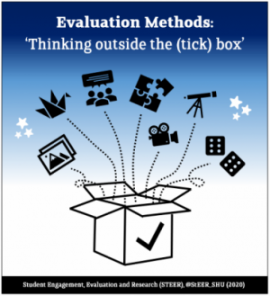We explore evaluation and research methodologies that could be used in your own evaluations. Many of the resources in this section are case studies based on the evaluative work undertaken by STEER.

Digital Storytelling
The aim of digital storytelling is to provide a novel platform to empower and give voice to individuals or groups who are often overlooked in mainstream culture (Clarke & Adam, 2010). In its traditional form and core function, digital storytelling refers to the process of developing personal narratives based on certain life experiences, with those stories being supported by a combination of text, audio recordings, images, music and animations to create short films (Benick, 2012; Davis, 2011). Digital storytelling is currently used in educational settings as a tool for reflection, as an inclusive assessment, to encourage community engagement, as a formative approach to prepare presentations and to build belonging in online settings.
This video will explore digital storytelling as a tool for amplifying student voices in higher education.
- Key outcomes: An understanding of what digital storytelling is. An awareness of how digital storytelling has previously been used at Hallam. An appreciation of how digital storytelling could be used in online/blended learning environments.
- Who should watch: Staff and students who may be interested in using digital storytelling to evaluate the learner experience. For example, Module Leaders, Academic Advisors, Student Reps/Student Ambassadors.
- Engagement with the video: Viewers will benefit from watching a selection of student digital stories before watching this video or pausing to watch during the video. These stories, and a selection of additional resources and publications, can be found on the STEER blog
- Accompanying resources:
Appreciative Inquiry
This short video outlines the approach to Appreciative Inquiry (AI) used at Sheffield Hallam University. It describes the stages involved and the various uses of AI as an evaluative tool and includes links to case studies about how AI has been used at Sheffield Hallam.
- Key Outcome: An understanding of the five stages of appreciative inquiry and how they might be used to evaluate both participant and practitioner experiences.
- Who should watch: This video is relevant to all staff at Hallam who are designing individual activities and interventions (e.g. peer mentoring, workshops and events) or programmes of change (e.g. course/programme level developments). This also includes learning and teaching activities (e.g. module and course designs and changes to assessment methods) and mechanisms for determining and reviewing strategic change (e.g. committees / working groups and quality enhancement processes).
- Engagement with the video: Viewers may find it useful to think about a current or planned activity or project which is likely to benefit from a qualitative evaluation of participant and/or practitioner experiences.
- Accompanying resources: Case study 1 – Appreciative Inquiry and NSS. Case study 2 – Using Appreciative Inquiry as an evaluative approach to course enhancement.
Using Caricatures for Evaluation
This video will explore how caricatures can be used as a creative methodology in evaluation.
- Key outcomes: An understanding of how creative methodologies can be used in evaluations to measure change over time and demonstrate the impact of interventions.
- Who should watch: Staff and students who are interested in evaluation and creative methodologies. This video is applicable to all levels of evaluation experience.
- Engagement with the video: Viewers might want to explore other literature on creative methodologies in evaluation.
- Accompanying resources:
Listening Rooms
Listening Rooms is about hearing the authentic student voice and actively listening to student experiences. The Listening Rooms Project is unique to HE and comprises two innovative methods working together to bring about positive institutional change.
Inspired by BBC Radio 4’s The Listening Project and StoryCorps, Listening Rooms capture real conversation between friends. The conversations are then discussed and analysed by relevant stakeholders, enabling decisions to be made on better and truer understanding of the lived student experience.
Learn more about the Listening Rooms at Sheffield Hallam University
Surveys
Surveys are a dominant research methodology in Higher Education, but they can be beset with high levels of student non-response rates. Within STEER, we have constructed an evidence-informed process, known as the Survey Research Design Checklist (SRDC). If you are using a survey, consult the checklist and this accompanying blog post to learn about the factors you should consider at the point of design, which includes the following:
- Access to survey
- Level of student support
- Incentives
- Optimal length of survey
- Timing and possible information fatigue
- Question wording and ordering
- Survey question formats
- Reporting and debriefing
